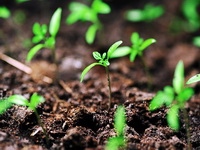![]()
 We are living in the times when it seems to make sense to grow your own food for a variety of reasons. It is no secret that our food supply has been seriously tampered with by the corporations that are in charge of processing and marketing the food. One also wonders how the food supply will be handled in the future, so it is reasonable that setting aside a store of home grown food is a good idea.
We are living in the times when it seems to make sense to grow your own food for a variety of reasons. It is no secret that our food supply has been seriously tampered with by the corporations that are in charge of processing and marketing the food. One also wonders how the food supply will be handled in the future, so it is reasonable that setting aside a store of home grown food is a good idea.
If you can grow an extra supply of food in your own garden and then store it for emergencies you can be assured that you know the source as well as the viability of your food. In order to grow crops that you can rely on for you and your family, you will need to grow staple crops, or in other words crops that are the staple basis of the human diet.
A staple crop would be easy to grow, easy to harvest and store, and be dense in calories in order to provide the necessary energy and nutrition that is needed each day.
Let us begin the list by highlighting potatoes. Remember, potatoes were the staple crop of Ireland just before the “potato famine” in the 1800s. Potatoes give the most calories for the least ground space. They are very easy to grow because all you have to do is bury a piece of a potato about the size of an egg and you’re all set, as long as there are a couple of “eyes” on the planted piece. Potatoes will be ready to harvest in about 65 to 90 days in most cases, depending upon the variety.
One of the healthiest foods that we can eat are sweet potatoes, due to their extremely high beta carotene content. They are heat lovers and grow very well in hot climates, although they can be grown in the United States as far to the north as Canada.
There are three varieties of corn. There is flint corn, flour corn and dent corn. Flint corn is better situation for wetter, cooler climates and is the hardest to grind. Flour corn is best grown in the Southwestern regions of the US by Native Americans, and it is the easiest to grind. Dent corn has a dent in the kernel at the top, and is most commonly field corn. It is unfortunate that most of the dent corn available is now genetically modified.
All types of corn can be ground for use as cornmeal, johnnycakes and puddings. Flour corn makes the best pancakes and cornbread. Be on the lookout for seeds that have been open-pollinated and then save the seeds of the plants. The seeds from the flint varieties can be saved for 5 to 10 years.
Heirloom wheat is another crop worth growing and harvesting. There has been quite a bit of study as far as how the genetically modified varieties of wheat have probably been the cause of the gluten intolerance that seems to be sweeping the country. The wheat of today has been engineered to withstand storms with its heavier stalk and larger grains, and has been made resistant to insects, and one wonders what that has done to us humans.
Heirloom wheat is more like the wheat of old, as it can be higher yielding and people who are gluten intolerant have been reported to have been able to eat it with no problem.
Legumes, or dry beans are a major part of food plans that emphasize storage. You won’t make a lot of money growing this type of crop for the market, but you will make a big hit for the addition to your own food supply. Beans have more than 1,500 calories per pound and that also equates to about 13 to 17 servings per pound as well. Good cool weather legume crops are peas, lentils, garbonzo, and fava beans. All the rest of the bean varieties grow better in warmer weather.
The more popular varieties are black beans, red beans and lima beans. Pick a few and experiment with what types grow best in your soil. They can be stored for up to three years, but are best when they are served right away.
Kale and collards are members of the cabbage family and are among the most healthy and nutritious plants on the planet. They are “cut & come again” crops as they can be grown and left and even can be harvested during the winter, as they can be “stored” in your winter garden. They have a very high calcium content.
All kinds of leafy greens are a must during the warmer months, as well as tomatoes which are easy to grow and easier to eat at they go with just about any mean, and are good to eat by themselves too.


 OneCareNow is a general weblog that was created by several writers with a specific goal in mind: To offer one place that covers important topics which people really care about.
OneCareNow is a general weblog that was created by several writers with a specific goal in mind: To offer one place that covers important topics which people really care about.![Back Pain Breakthrough by Palmer & Dr. Young [2024 Review]](https://www.onecarenow.org/wp-content/uploads/2021/02/Back-Pain-Breakthrough-Young-Amy-50x50.png)
![Vincent’s Midas Manifestation System Review [Updated 2024]](https://www.onecarenow.org/wp-content/uploads/2021/02/Midas-Manifestation-50x50.png)
![The NEW Happiness Code by David [Updated 2024 Review]](https://www.onecarenow.org/wp-content/uploads/2021/01/The-NEW-Happiness-Code-50x50.png)
![Michael Christianson’s Manifestation Sigil Review [2024]](https://www.onecarenow.org/wp-content/uploads/2021/01/Manifestation-Sigil-50x50.png)
